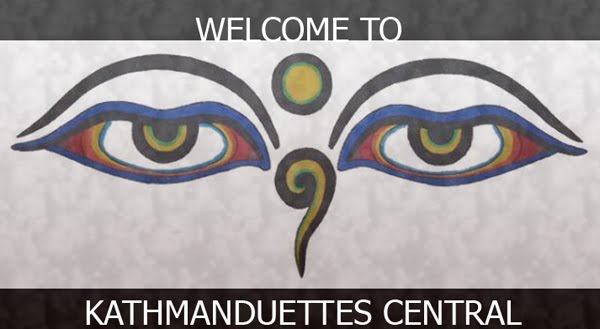 Photo: Rakshi's doppelganger
Photo: Rakshi's doppelganger.
Once a month usually on Saturday mornings were bath times: they used special pet shampoo from Germany, and when that ran out I bought Lux beauty soap for them, advertised heavily by Bollywood actresses. Maheshwori and Gyano were the didis who pampered them with their baths, towel rubdown, lots of combing and brushing and hairclips in place. David would call the Lhasas the "Cosmo Girls" when they were all preened up and soft to the touch. Because of the double undercoat, brushing was quite an operation, and quite painful I suppose. So once a year in the summertime, the fur would be clipped and would soon grow quickly. Khukri, while living in Germany, had to be anesthesized before being brushed.
In the mornings, soon after they are let out from the Doggie Hotel, they would come to bed with us and play: Paisa, in her two tone bark, would slip on the floor while trying to climb up, and the others would already be in place in the duvet. When MoMo the Siamese joined the household, he would also accompany the Lhasas into the morning bed venture.
The Bhandarys, our landlords who occupied two of the four houses in the compound, had a large dog named Capo, and joined the pack in their "jollifications" at the compound. They also had a smaller one, Clever, who was truly shrewd and knew exactly when to go for the food bowls, but to be chased away by Gyano: but was promptly returned when Gyano turned her back.
On Tihar, Dashain and other festival days, they were accorded proper respect (male dogs only): Gorkha was placed on a table covered with a special cloth, garlanded, offered Grade AAA buff meat, special cookies, gulab jamun, marigold petals, incense smoke around his face: alas this was not enough to conquer the parvo virus. The others would merrily join in the celebrations, and would get the same colored powder as the rest of the adults and children in the compound. We had a thriving double-petal Filipino sampaguita bush, courtesy of Alice and Ed Perdon, and each morning the plentiful blossoms were put into good use for the pujas: pets included.
And the lovely rainy days!! (which surely the rain in the Valley turned to snow in the Himalayas) We had large picture windows running alongside the living room and bedroom: In the mornings they would romp around in the rain, then shake off their shaggy muddy coats at the windows (which would have been freshly washed by Gyano) and walk alongside from the bedroom to the living room windows. Then they would get the towel treatment, paws cleaned, and allowed to come inside and would sit by the fire. But MoMo would station himself next to the kerosene heater from Mercantile: often the top would have a tin teapot warming.
Rakshi was easily David's fave: she was slimmer and more agile than the rest, and had black and white coloring while the others had an overall grayish - black tone. With tufts of hair near the eyes and nose giving her a puppy-forever look. She had the most shrill bark and had a smallish face and delicate bones, like a bird's. She responded most to David's voice and was most alert when we sat outside at the lawn and keeping to his side all that time while we took our South Indian coffee and Geneva chocolates.
When Pema was brought home from the spanking-new Patan Hospital, my mother, who was visiting, advised that she should be exposed to sunlight about thirty minutes a day. The first time I took Pema in her swaddles, the doggies came over, sniffing her all over, and stayed with us for those minutes that she was taken outdoors. Then the swaddles started coming off so her skin could take in the sunlight: the doggies were always around for this, always circling and sniffing her from head to toe. It was soon time to bathe her head in mustard oil, to stimulate hair growth: the doggies did the most of their sniffing around this area.
I do not recall Ching' and Marlin's Lhasa name, but had the opposite of an overbite, (underbite?) again a mark of pedigree Lhasas. And was larger than the ones we had. The Perdons too had Lhasas, in addition to their outdoor guard dogs: which were later given to (now late) Father Watrin when they left Kathmandu. Dr. Dioscoro Umali, FAO Representative for Asia and the Pacific, was taken by these Lhasas: a special order by Ching and Alice, was placed for two puppies to be sent to his office in Bangkok, and they were subsequently shipped to Los Banos after their tour of duty. And I heard from third parties, that when one of the Lhasas died, years later, Mrs. Umali was inconsolable. Lhasas do that to humans.
 Here are some clues:
Here are some clues:

